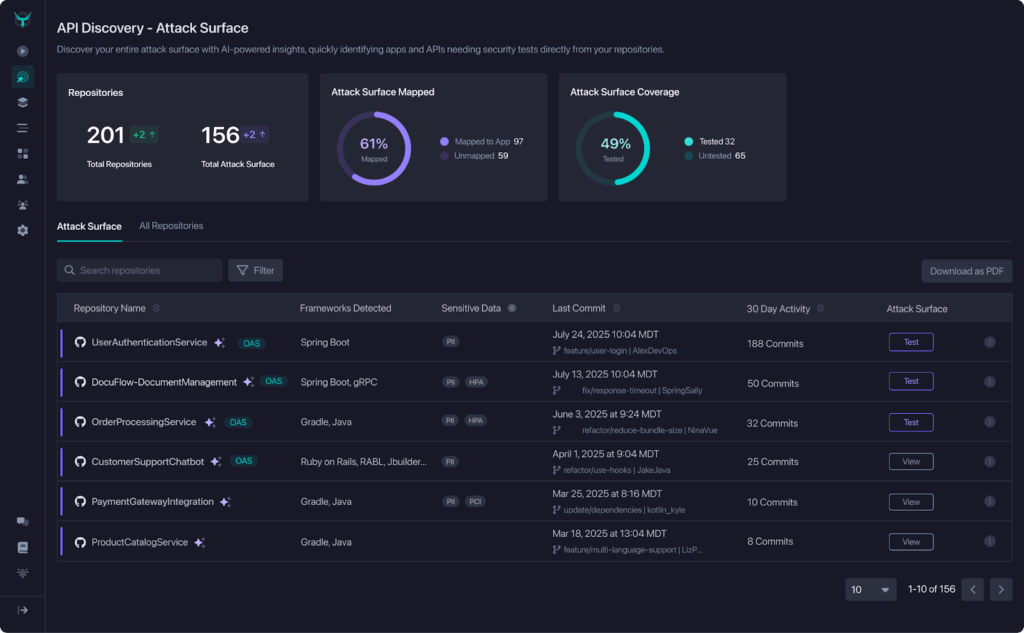The old adage “you can’t secure what you can’t see” has never been more true. As AI coding assistants accelerate development, applications and APIs proliferate faster than AppSec teams can discover them—let alone test them.
According to ESG research analyst Melinda Marks, 87% of organizations worry about shadow and undiscovered APIs, with 38% calling it a significant concern. Every undiscovered API represents untested attack surface. And what you can’t see, you can’t test.
For AppSec teams trying to scale DAST coverage, the challenge isn’t just running scans—it’s knowing what to test in the first place. You can have the best DAST engine in the world, but if it’s only testing a fraction of your actual attack surface, you’re operating with a false sense of security.
Why DAST Adoption Stalls at Scale
DAST requires two critical pieces of information for every application: how authentication works and where the application runs. Multiply that configuration tax across hundreds of applications, and you see why DAST coverage stalls. But there are two even more fundamental problems:
First, you can’t configure DAST for applications you don’t know exist. Most teams discover APIs after they’re deployed—through production scanning, pentests, or worse, security incidents. Manually tracking them in spreadsheets doesn’t scale when AI-generated code ships multiple times per day.
Second, even when you know applications exist, you can’t tell which ones actually would benefit from application (and specifically, runtime application) security testing. Not everything in your repos is attack surface. Your documentation repo, Python package library, and Terraform configs don’t need testing. But without analysis, AppSec teams waste cycles trying to configure runtime for repositories that aren’t even applications.
The result? AppSec engineers lie awake at night wondering: What apps and APIs actually exist? And of those, what are the riskiest and actually need testing?

Meanwhile, critical payment APIs slip through untested while teams waste time triaging code security alerts in low-risk repos.
Code-Based Visibility: The Foundation DAST Needs to Scale
Six years ago, we built one of the most developer-friendly, performant DAST engines on the market. But here’s what we learned: we don’t have a testing problem—we have a visibility problem. DAST can’t scale when discovery is the bottleneck.
That’s why we launched API Discovery from code—to solve the fundamental challenge before testing even begins.
The difference is timing and accuracy. Instead of waiting for APIs to appear in production, we discover them from source code the moment they’re committed. StackHawk integrates directly with your source control (GitHub, GitLab, Bitbucket) to continuously analyze repositories. We automatically identify every API endpoint, microservice, web application, authentication scheme, and AI/LLM component.
Your repos become the single source of truth. You know what’s coming before deployment, you find shadow APIs and internal services, and your attack surface map updates in real-time.
How Visibility Unlocks DAST at Scale
Know What to Test (and What Not to Test)
Not everything in your repos needs DAST. Our analysis automatically identifies what actually warrants testing vs. what doesn’t—stopping your team from wasting time trying to configure DAST for documentation repos, package libraries, or infrastructure-as-code that isn’t attack surface. This eliminates the noise before testing begins.
But discovery also surfaces which applications are internet-facing, handle sensitive data, and change frequently. Instead of blindly testing 100 applications equally, you focus DAST resources on the 15 that actually matter. This is how small AppSec teams keep up with large development organizations.
Generate the Documentation DAST Needs—Continuously
Comprehensive DAST requires OpenAPI specifications. Many teams either don’t have specs or their specs are outdated minutes after creation—blocking testing before it can start.
StackHawk automatically generates OpenAPI specifications using code analysis and AI. No manual spec writing. No maintenance overhead. If the code exists, the spec gets generated. If the spec exists, DAST happens.
But here’s where continuous discovery becomes critical: AI-accelerated development means your attack surface isn’t static. New endpoints appear daily, existing ones change hourly. Traditional discovery through production scanning means DAST configurations are always out of date—you’re testing yesterday’s APIs while today’s are already shipping.
Code-based discovery updates continuously as developers commit code. New APIs, modified endpoints, and changed authentication schemes trigger automatic spec updates and re-analysis. Your DAST coverage keeps pace with development velocity because discovery and spec generation happen in real-time, not on weekly scan schedules.
Prove DAST Program Effectiveness
Without visibility into your complete attack surface, you can’t answer: “What percentage of our applications are actually tested?” You might be testing 50 applications and feel good about your DAST program—until you discover you actually have 200 applications and only 25% coverage.
By combining attack surface discovery with testing coverage tracking, you finally see the full picture: total attack surface size, coverage rate, which high-risk applications are untested, and where to focus expansion efforts.

This is how you prove DAST program effectiveness to leadership. You walk into board meetings and say: “Last quarter we had 247 applications with 62% DAST coverage and 18 open critical vulnerabilities. This quarter we’re at 265 applications with 81% coverage and 0 open criticals. Risk is measurably decreasing despite application growth.”
The Shift from Reactive to Proactive DAST
At StackHawk, we truly believe that application security testing is only as effective as your discovery process. Reactive discovery through production scanning means you’re always playing catch-up and manual inventorying never could keep up and certainly won’t now.
Code-based application attack surface mapping transforms DAST from reactive to proactive: you know what to test before it reaches production, you automatically generate the specs DAST needs, you focus resources on what actually matters based on risk, and you scale coverage to match development velocity.
Stop discovering vulnerabilities after they’re exploitable. Start discovering your attack surface from code—and testing it at scale.
